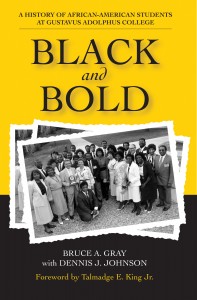Former Dean of Students Bruce A. Gray ‘61 tells a story that has largely been left untold in the  recounting of Gustavus history in his new book, Black and Bold. Utilizing interviews, personal experience, archival records and historical photographs, Gray begins the memoir with his initial recruitment of black students to Gustavus in the 1960s and ‘70s and ends with his ongoing relationship with both former and current students at Gustavus.
recounting of Gustavus history in his new book, Black and Bold. Utilizing interviews, personal experience, archival records and historical photographs, Gray begins the memoir with his initial recruitment of black students to Gustavus in the 1960s and ‘70s and ends with his ongoing relationship with both former and current students at Gustavus.
The early trials and subsequent successes of the students Gray recruited, both during their time at Gustavus and beyond it, laid the foundation for the positive legacy that Gustavus carries forward in its commitment to provide opportunities to a diverse campus of young men and women.
During his interview, Gray’s views on diversity and cultural appreciation were as clear and strong as his opinions expressed in his memoir.
“The world’s different. We better learn about every different culture we can find,” Gray said.
Interaction between black students and the St. Peter community in the early years of recruitment is covered in a chapter of his book, the chapter Gray found the most difficult to write. There was certainly tension in the predominantly white, Lutheran community. Yet there were also many townspeople who reached out and were willing to extend the hand that others withdrew.
Gray stressed the influence his work had on his daughters growing up as their family welcomed and supported the newly recruited black students.
“We grew up as Gusties saying everyone is equal,” Gray said.
His work was closely linked to his personal life, and the Gray family frequently hosted students for dinners and holiday breaks and maintained close, long-term relationships with many of them.
Gray held great conviction in the worthy goal of then president Edgar M. Carlson ‘30 in the advancement of civil rights and the necessity to provide an equal opportunity for higher education. Gray advised the Black Student Organization when it was first founded (now the Pan Afrikan Student Organization), and in fact, eight years ago Gray and his wife Sue founded an endowed scholarship for students demonstrating financial need.
Written with the help of former president Dennis Johnson ‘60, his book is now available at the Bookmark. His book is also held at the Nicollet County Historical Society, and he plans to donate the remainder of his files collected as dean and admissions officer to the college archives.
Gustavus has grown and matured as an institution since Carlson and Gray collaborated to bring more diversity to the Swedish Lutheran campus. Assistant Dean of Students and Director of Diversity Virgil Jones said that the increase in diversity over the last ten years and the increase in leadership positions held by these students has been a very positive change for the college.
Sophomore Biology major Daniel Ly said he feels there is such a sense of deliberate and welcome inclusion on the campus, that he doesn’t feel like he’s a minority.
“My floor mates attribute my using chopsticks when I eat ramen to me eating ramen as a college student, not as an Asian student,” Ly said.
Jones, however, believes there is still work to be done to bring a more diverse faculty to Gustavus and increase tenured faculty of diverse backgrounds. In Gray’s book, Phil Bryant ’73 is listed as the only tenured African American faculty in the 150 year history of the college. This is the problem that Jones believes needs to be addressed next, but it is up to the Administration and Provost’s Office.
“Faculty diversity is their responsibility. We need to think about strategies that promote a more diverse applicant pool and processes during the hiring phase that promote the hiring of more diverse applicants as well,” Jones said.
Both Gray and Jones agree that students need to be more vocal about inclusion and how it relates to the core values of the college. Gray hopes that when students, faculty and alums read his book, they will reflect on these ideas and engage in discussion on how the college can forward its mission towards greater cultural appreciation and campus diversity.